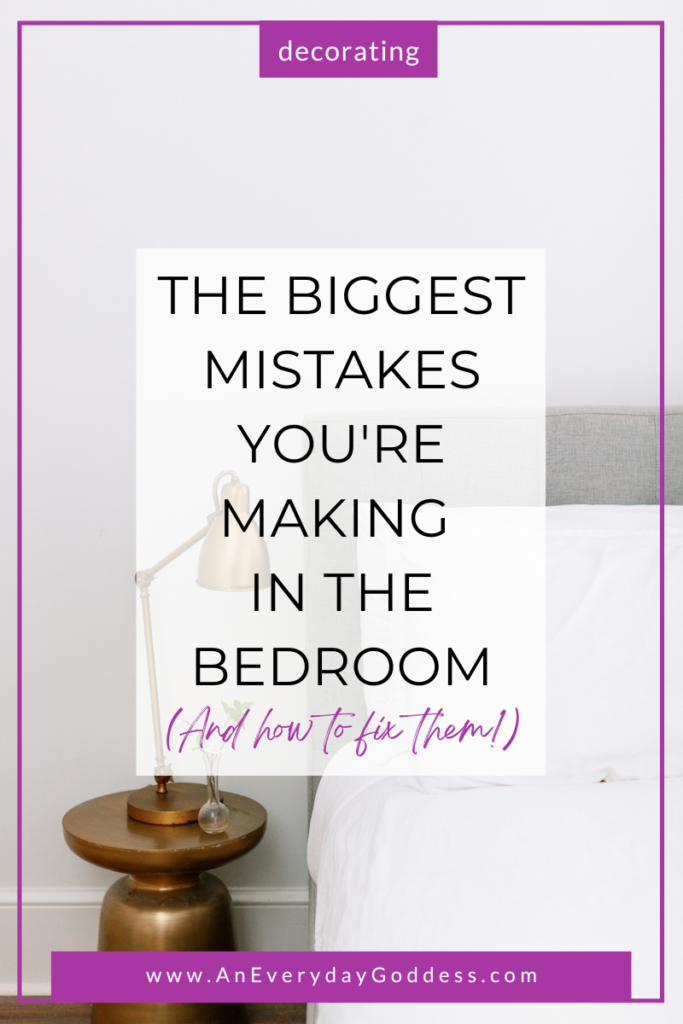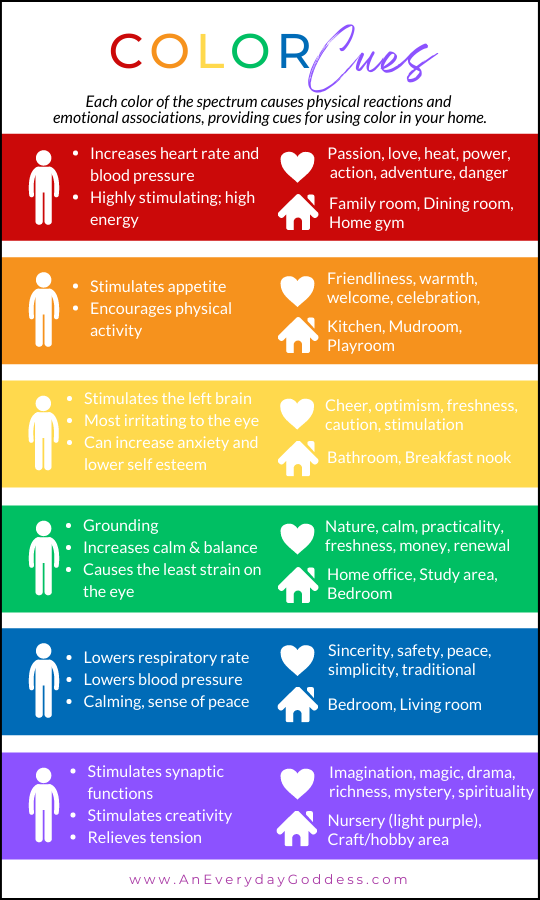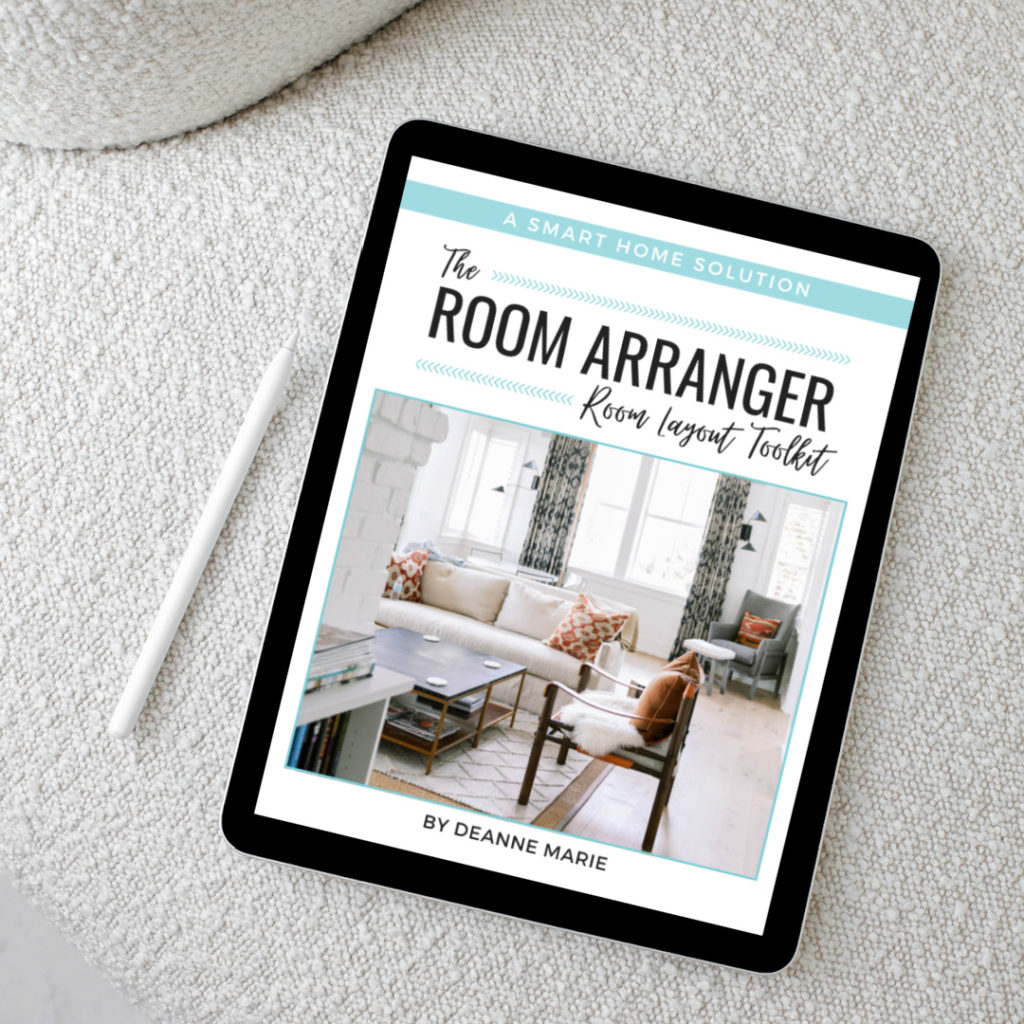
Sleep is pretty amazing. Sleep literally allows our bodies to repair and regenerate, so we feel refreshed in the morning. But if sleep feels anything but refreshing, your bedroom might be part of the problem.
A well-designed bedroom has the power to help us sleep better, and feel more confident, more relaxed, more at peace, and more energized to take on the day.
According to the National Sleep Foundation, a growing body of evidence shows that the conditions of your sleep space—the sights, sounds, feelings, and even smells—can either help or hurt your ability to fall asleep, stay asleep, and wake up feeling rested and energized.
If any of these elements isn’t supporting a restful, calming space, it can throw off your sleep. Through both personal experience and helping my clients makeover their bedrooms, I’ve put together the top five decorating mistakes that I see over and over—and I’m giving you solutions for each bedroom mistake. Ready? Here we go!
Bedroom Mistake #1: Ignoring your bedroom.
Signs you’re making this bedroom mistake:
- The bedroom is the last room to be done in your home.
- It’s mish mash of furniture.
- There’s no focal point or a headboard.
- It looks and feels like a storage locker.
- You can’t remember how old the mattress is.
The effect on you: The bedroom is the most personal room for anyone living in your home, including you. Therefore, having a bedroom that you ignore not-so-subtly says, “My comfort is not important. My needs are not served. I have no place to rest.” Ouch!
Remedy: Make your bedroom a priority and create a plan! Focus first on the bed, making it a welcoming place. This could mean anything from a new duvet cover to a new mattress or a headboard. We’ll talk more about clutter later, but keep the plan simple. Don’t over complicate at this stage. And, make an effort to make the bed in the morning. Just that alone can help the room feel more serene and give you motivation to keep the room neat and tidy.
Bedroom Mistake #2: Color errors.
Signs you’re making this bedroom mistake:
- You feel agitated for no apparent reason.
- You often feel anxious and unable to sleep.
- You feel like you can’t relax.
Effect: Color is light, and light is energy. In fact, color is the only energy we can see. Energy affects us both psychologically and physically. Colors can stimulate, excite, depress, tranquilize, increase appetite and create a feeling of warmth or coolness.
In our bodies, color impacts the hypothalamus gland which governs everything from water regulation, metabolism and body temperature to appetite, sexual functions and—you guessed it!—sleep and behavioral patterns.
Look around your bedroom and note what colors you see on the walls and floor, bedding and artwork, then see what effect those colors have on the body in this handy chart. (Tip: Pin this infographic to a Pinterest board!)

Remedy: Keep bedroom spaces to calming neutrals, greens and blues. Change out linens to more soothing colors and patterns. If the walls are red, orange, yellow or anything dark and foreboding, repaint them. Renting? Ask the landlord if you can repaint; but if not, use removable wallpaper or drape the walls with fabric to tone down harsh colors.
You might be tempted to red to induce passion in the bedroom, but use it sparingly, as an accent color. One of my clients complained about back pain when she woke up. I asked her what color her sheets were, and she said red. I advised her to change her sheets and she reported that her back pain vanished. So pay attention to the color of your sheets!
Bedroom Mistake #3: The bedroom serves too many purposes.
Signs you’re making this bedroom mistake = doing more than four of these things in the bedroom:
- Watching TV
- Talking on the phone
- Working on the computer
- Responding to emails on your smartphone or tablet
- Doing hobbies and crafts
- Reading
- Exercising
- Paying bills
- Folding laundry
- Ironing
- Feeding the dog
- Housing the litter box
- Sleeping
- Being intimate
Effect on you: Your bedroom is no longer the sanctuary. It provides no respite from everyday life, work and demands. A big culprit is using an electronic gadget before sleep. Light from electronics has the potential to disrupt sleep. The blue light given off by electronics like computers and cell phones has been shown to delay the release of melatonin, which is a hormone that helps regulate the sleep cycle.
Remedy: Simplify and pare down the uses for your room. Make a list of everything you do in there, and see if there’s another, more suitable place in your home for that activity. The ultimate goal is to get the bedroom down to sleeping, intimacy, reading and relaxing. If your bedroom absolutely must serve multiple functions, consider a piece of furniture that can be closed and return the bedroom to a bedroom, or placing the exercise equipment behind a screen, for example. Using a tool like my Room Arranger can help envision a new furniture plan.
Bedroom Mistake #4: The bedroom is cluttered.
Signs you’re making this bedroom mistake:
- You have to move stuff off the bed to sleep.
- Your nightstands look like a catch all.
- You don’t have a dresser or other storage piece.
- Stuff is everywhere, on the dresser, on the floor.
- It takes more than 2 seconds to find something on your nightstand.
- The laundry stays in a basket.
Effect on you: Clutter in the physical world leads to mental clutter, annoyance and irritability. Clutter makes us distracted and unable to focus; it competes for our attention on an energetic level, wearing down our resources to the point of frustration. Physical clutter overloads your senses, making you feel stressed.
If we want our bedroom environment to be a restful oasis, then clutter has no place there. Researchers at Princeton University Neuroscience Institute found that we are less irritable, more productive, distracted less often, and able to process information better as we clear clutter from our home and office environments.
Remedy: Getting organized isn’t the same as being organized; it could take a mindset shift to finally conquer clutter. The first rule of decluttering is to analyze what the clutter is, and why it got there. If your nightstands are a mess, find out why. Do you need more storage to stash necessities like hand cream and reading glasses? If you have laundry strewn everywhere, do you need a larger dresser, or more organization in the closet? Some potential fixes:
- Get bachelor chests with drawers for either side of the bed, as space allows. An ideal height is between 24 and 28 inches.
- Use pretty bins, baskets or boxes for necessities and bedside essentials like your journal or a pen.
- Clean out your closet; reconfigure closet and move clothing storage to the closet.
Bedroom Mistake #5: There’s too much—or not enough—light.
Signs your bedroom has too much light:
- Daylight routinely wakes you up, even if you’ve only been asleep a few hours.
- You can’t make it through a work day without feeling groggy.
- You can’t sleep during the day when you need to (say you work nights or you’re sick).
- You have no window treatments at all.
Your bedroom has too little light if:
- You get to the office and realize you have on one black shoe and one blue shoe.
- People ask, did you get dressed in the dark?
- You often bump into walls or furniture trying to get to bed.
Effect on you: Too much light leads to insufficient sleep. (I was shocked to learn that 34% of Americans don’t have any kind of window treatments at all in the bedroom. What??!?) We wake up grumpy, and aren’t as productive during the day. Some studies even show an increased risk of colon cancer sleeping in a room that has any light.
Remedy: If there’s too much light in the bedroom, install room-darkening blinds or drapes. These do not have to be expensive. Simple room darkening roller shades are available at home improvement centers are easy to install with just a screwdriver in most cases.
If there’s not enough light, find ways to add new light sources. Check the maximum wattage of a ceiling fixture and install brighter bulbs if possible. If you read before bed, bedside lamps are essential, with the right height, angle and brightness. Replace the contractor-grade fixture with a chandelier to make the room feel special. Ceiling fans are OK and a must in some areas of the country.
Putting It All Together – Tips for Success
Have a plan and a vision in mind. Make a Pinterest board of how you want your bedroom to feel and look. Then, create a detailed task plan, budget and shopping list.
Start where you can. For most people, that’s decluttering. It’s free and helps clear the space for wonderful things to come. Even rearranging the furniture can make a big impact. (Tip: Try my Room Arranger to figure out a new layout.)
Create a budget, then prioritize and phase your project. Things like paint and new bedding can be the quickest, cheapest fixes and help set the tone for the whole project. When I designed my dream bedroom for my Vegas house, it wasn’t cheap. It came together over the course of about two years as savings allowed.
May I ask a favor? If you liked this post, share it with your friends and followers on one of these platforms:


 Hi! I’m Deanne Marie – designer, author, attorney, travel enthusiast and everyday goddess. I love showing other single professional women how to create a home that is as comfortable as it is stylish, and have joy-filled, everyday goddess kind of life.
Hi! I’m Deanne Marie – designer, author, attorney, travel enthusiast and everyday goddess. I love showing other single professional women how to create a home that is as comfortable as it is stylish, and have joy-filled, everyday goddess kind of life.
